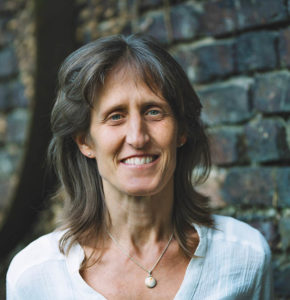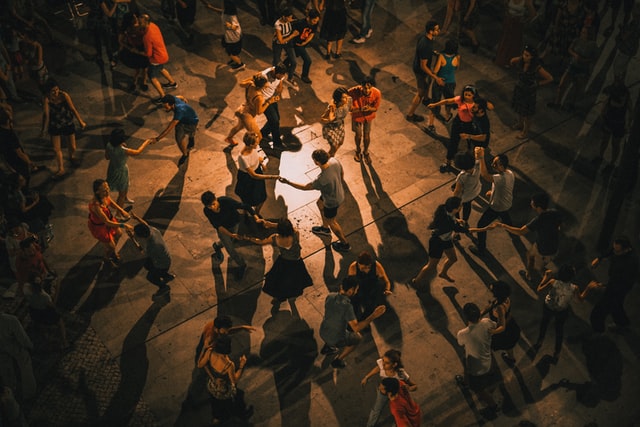By Amona Buechler, GCFP CM
“Owing to the close proximity to the motor cortex of the brain structures dealing with thought and feeling, and the tendency of processes in the brain tissue to diffuse and spread to neighboring tissues, a drastic change in the motor cortex will have parallel effects on thinking and feeling.
A fundamental change in the motor basis within any single integration pattern will break up the cohesion of the whole and thereby leave thought and feeling without anchorage in the patterns of their established routines. In this condition, it is much easier to effect changes in thinking and feeling, for the muscular part, through which thinking and feeling reaches our awareness has changed and no longer expresses the pattern previously familiar to us. Habit has lost its chief support, that of the muscles, and has become more amenable to change.”
-Moshe Feldenkrais, Awareness Through Movement
My ex-partner introduced me to Salsa dancing, and when we separated years later, I decided to continue going solo, despite not having much confidence. We’d mostly danced together; he tended to do his own thing and not quite go with the Salsa rules.
Being solo, I was dancing with ten to twenty men in one evening without the opportunity to tune into one person. It quickly became apparent that I needed to stick with the rules.
Feeling like a beginner again was very intimidating. For months, I convinced myself to go regularly. I’d take a few deep breaths and sit with the feeling before getting myself out of the house, away from familiarity and comfort.
On the dance floor, I discovered a tendency to hold my breath whenever I did something wrong in fear of being a disturbance to my dance partner and in fear of
the next mistake to come. I began a practice of internally reminding myself “Amona, breathe,” whenever it happened.
I noticed that some women had big, joyful smiles on their faces throughout the entire song or even night, regardless of whether they danced perfectly. I began to wonder how they did that. Were they not affected by their mistakes? In contrast to them, I frequently had a seriousness come over my face. I could feel it internally, in my musculature. So, I decided to experiment with smiling whether or not I felt like it, thereby using my musculature in new ways during habitual emotional and mental reactions.
Besides figuring out the correct steps and rhythm, I’d entered into a practice of breathing and smiling. Several months later, I could not believe the effect. My smile now comes from the inside out, from a very deep place in myself. More often than not, I find myself laughing when I make a mistake, or even inventing new moves out of what “went wrong.” It has often felt like I can’t get my joyful grin off my face. I wouldn’t want to, anyway. Going dancing has become a precious source of joy and rejuvenation.
It may be worth considering and sharing here that, based on my meditation and Focusing practice, I always hesitate to use such “physical” “artificial/make believe” tools. From the perspective of the kind of practices I am mostly involved in, making myself smile when not feeling it would be similar to going to a doctor who prescribes you a medicine that suppresses the symptoms but doesn’t address the root-cause of the illness. Instead, one would be with fear, without any manipulation or interference of any sort. Just the readiness to consciously feel it, watch it, let it be without making a story of it, and not making it right or wrong.
My favored practices remain those which have a very non-invasive quality, in which, through self-observation, changes occur gradually, and seemingly out of nowhere. For example, in the above-mentioned situation I am still vulnerable to others’ opinions about myself, whether I feel respected alters how I experience myself. So, there are evenings when I go dancing and the “I am not doing it right” uncertainty takes over and with it all the old habitual patterns. It has become rare, but it’s there. On a deep level, I have to admit to myself that I am still operating in the realm of right and wrong more often than I wish, and continuing to move away from that may require a deeper inquiry than changing a muscular pattern.
Through this experiment, however, artificially introducing unfamiliar options, and interrupting habitual (physical) behavior, I myself experienced Moshe Feldenkrais’ statement to be true:
“…for the muscular part, through which thinking and feeling reaches our awareness has changed and no longer expresses the pattern previously familiar to us. Habit has lost its chief support, that of the muscles, and has become more amenable to change.”
This “making myself smile” reached a very deep place in myself. Over time, it did not remain a cosmetic correction; instead, it supported releasing a deep-rooted mental and emotional habit of putting myself down when making mistakes.
***
The other day, I received a parking ticket. At first, I was really mad. So, I paused, as I usually do in any situation alike, and reminded myself to relax my muscles, especially my hands, jaw, lips, mouth, forehead, belly, and breathing. The emotion and negative interpretation of the situations “want” to create superfluous tension all over my body. While staying present, relaxing and breathing, however, the parking ticket quickly became unimportant, almost forgotten, just one of the numerous things I would not choose to have happened if I could. A spontaneous relaxation took over.
Without many years of training in sensing the subtlest superfluous efforts in my body, I would have simply not been aware of how my thoughts and emotions manifest on a physical level. Now that I have attained this capacity through practicing hundreds of Awareness Through Movement® lessons, I am able to feel the subtlest “parasitic efforts” and thereby have an access point for positive change. The result of those “physical” changes is always a more relaxed attitude, a deeper breath, and increased well-being.
These may seem like small examples, but I am amazed to notice how the undercurrent energy of my life has changed to a much greater lightness of being; to experiencing gratitude as an undercurrent most of the time, rather than worry driven heaviness that was very familiar to me some years ago. However, while it has become habitual and natural to live with more lightness, it is definitely not automatic. It requires a deep, conscious remembrance and practice in difficult moments.
I suppose I may be a slow learner. I have practiced the Feldenkrais Method® for almost 25 years and have meditated for close to twenty, and it’s only during the last few years that I notice a fundamental change in myself. Today, I am pleased to state that I am living a life of happiness and wellbeing.
About Amona:
 Amona Buechler is a Guild Certified Feldenkrais PractitionerCM and a Certified Feldenkrais® Assistant Trainer. She is also certified as an advanced ARUN Conscious Touch practitioner, as well as a Focusing Trainer. Amona is now located in Leipzig, Germany, where most of her work takes place online. Amona is fascinated by self-exploration, through which she discovers her spontaneous and creative being, and guides others to catch fire for a path towards living themselves authentically and joyfully. Her website: move-with-life.org
Amona Buechler is a Guild Certified Feldenkrais PractitionerCM and a Certified Feldenkrais® Assistant Trainer. She is also certified as an advanced ARUN Conscious Touch practitioner, as well as a Focusing Trainer. Amona is now located in Leipzig, Germany, where most of her work takes place online. Amona is fascinated by self-exploration, through which she discovers her spontaneous and creative being, and guides others to catch fire for a path towards living themselves authentically and joyfully. Her website: move-with-life.org

